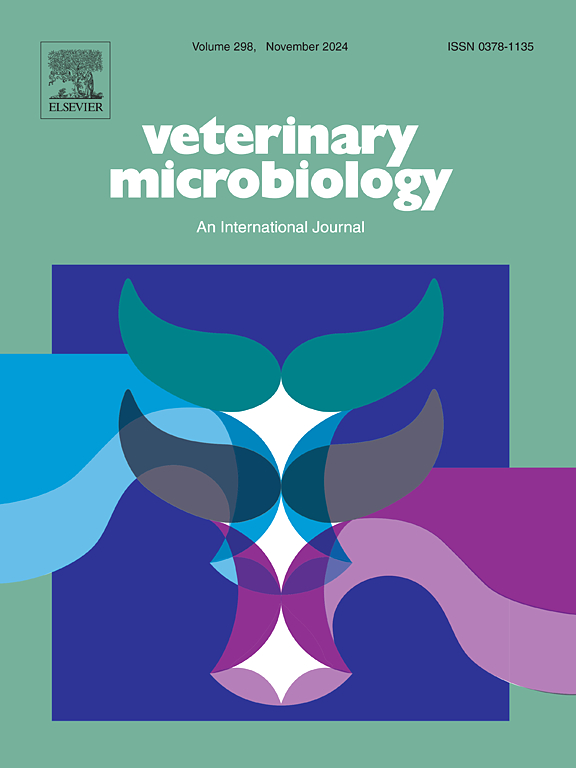Heat-inactivated Mycobacterium bovis and P22PI protein immunocomplex: Two candidates for use as immunostimulants of innate immune response
IF 2.4
2区 农林科学
Q3 MICROBIOLOGY
引用次数: 0
Abstract
Tuberculosis (TB), caused by members of the Mycobacterium tuberculosis complex, remains a critical global health challenge, affecting humans and a wide range of domestic and wild animals. Despite the availability of anti-TB drugs, cure rates remain suboptimal, exacerbated by the rise of multidrug-resistant TB strains. The Bacille Calmette-Guérin (BCG) vaccine, the only licensed vaccine against TB, has demonstrated efficacy in reducing lesion severity and bacterial burden in animals, as well as lowering TB-related and all-cause mortality in infants. However, BCG presents several safety concerns inherent to live vaccines. To overcome these limitations, exploring alternative vaccine candidates that do not incorporate live mycobacteria is crucial. This study aimed to evaluate and compare the immunostimulatory potential of two candidates based in mycobacteria inactivated or their derivatives, heat-inactivated Mycobacterium bovis (HIMB) and P22PI protein immunocomplex (P22PI), in bovine foetal lung cells. To assess the expression of innate immune components, including Toll-like receptors (TLRs), cathelicidins, and cytokines, bovine foetal lung were exposed to different concentrations of HIMB and P22PI immunostimulants, starting at 7.8 × 10⁶ CFU/ml and 10 µg/ml, respectively. These initial concentrations were subsequently diluted to 1/2 and 1/10 to evaluate dose-dependent effects. Our findings reveal that both HIMB and P22PI significantly stimulate innate immune mechanisms, as evidenced by the upregulation of TLR2 and TLR4, alongside the induction of BMAP28 cathelicidin, tumour necrosis factor alpha (TNFA) and interferons (IFNs). These results suggest their potential to orchestrate a robust innate immune response providing valuable insights into the immunological mechanisms underlying the protective effects of these immunostimulants. This underscores their potential role in in vivo studies as vaccine candidates. Furthermore, their ability to enhance antigen recognition via TLR and induce pro-inflammatory cytokines also indicates broader applications in immune modulation, potentially extending protection against heterologous pathogens through trained immunity.
热灭活牛分枝杆菌和P22PI蛋白免疫复合物:用作先天免疫反应免疫刺激剂的两种候选物
由结核分枝杆菌复合体成员引起的结核病仍然是一项重大的全球卫生挑战,影响人类和各种家畜和野生动物。尽管有抗结核药物,治愈率仍然不理想,耐多药结核菌株的增加加剧了这一情况。卡介苗(Bacille calmette - gusamrin, BCG)是唯一获得许可的结核病疫苗,已证明在降低动物病变严重程度和细菌负担以及降低婴儿结核病相关死亡率和全因死亡率方面有效。然而,卡介苗提出了活疫苗固有的几个安全问题。为了克服这些限制,探索不含活分枝杆菌的替代候选疫苗至关重要。本研究旨在评估和比较两种基于灭活分枝杆菌或其衍生物——热灭活牛分枝杆菌(HIMB)和P22PI蛋白免疫复合物(P22PI)的候选物在牛胎儿肺细胞中的免疫刺激潜力。为了评估包括toll样受体(TLRs)、抗菌肽和细胞因子在内的先天免疫成分的表达,将牛胎儿肺暴露于不同浓度的HIMB和P22PI免疫刺激剂中,分别从7.8 × 10⁶CFU/ml和10 µg/ml开始。这些初始浓度随后被稀释到1/2和1/10,以评估剂量依赖性效应。我们的研究结果表明,HIMB和P22PI都能显著刺激先天免疫机制,如TLR2和TLR4的上调,以及BMAP28 cathelicidin、肿瘤坏死因子α (TNFA)和干扰素(ifn)的诱导。这些结果表明,它们有可能协调一个强大的先天免疫反应,为这些免疫刺激剂保护作用的免疫学机制提供了有价值的见解。这强调了它们作为候选疫苗在体内研究中的潜在作用。此外,它们通过TLR增强抗原识别和诱导促炎细胞因子的能力也表明在免疫调节中有更广泛的应用,可能通过训练免疫来扩大对异源病原体的保护。
本文章由计算机程序翻译,如有差异,请以英文原文为准。
求助全文
约1分钟内获得全文
求助全文
来源期刊

Veterinary microbiology
农林科学-兽医学
CiteScore
5.90
自引率
6.10%
发文量
221
审稿时长
52 days
期刊介绍:
Veterinary Microbiology is concerned with microbial (bacterial, fungal, viral) diseases of domesticated vertebrate animals (livestock, companion animals, fur-bearing animals, game, poultry, fish) that supply food, other useful products or companionship. In addition, Microbial diseases of wild animals living in captivity, or as members of the feral fauna will also be considered if the infections are of interest because of their interrelation with humans (zoonoses) and/or domestic animals. Studies of antimicrobial resistance are also included, provided that the results represent a substantial advance in knowledge. Authors are strongly encouraged to read - prior to submission - the Editorials (''Scope or cope'' and ''Scope or cope II'') published previously in the journal. The Editors reserve the right to suggest submission to another journal for those papers which they feel would be more appropriate for consideration by that journal.
Original research papers of high quality and novelty on aspects of control, host response, molecular biology, pathogenesis, prevention, and treatment of microbial diseases of animals are published. Papers dealing primarily with immunology, epidemiology, molecular biology and antiviral or microbial agents will only be considered if they demonstrate a clear impact on a disease. Papers focusing solely on diagnostic techniques (such as another PCR protocol or ELISA) will not be published - focus should be on a microorganism and not on a particular technique. Papers only reporting microbial sequences, transcriptomics data, or proteomics data will not be considered unless the results represent a substantial advance in knowledge.
Drug trial papers will be considered if they have general application or significance. Papers on the identification of microorganisms will also be considered, but detailed taxonomic studies do not fall within the scope of the journal. Case reports will not be published, unless they have general application or contain novel aspects. Papers of geographically limited interest, which repeat what had been established elsewhere will not be considered. The readership of the journal is global.
 求助内容:
求助内容: 应助结果提醒方式:
应助结果提醒方式:


